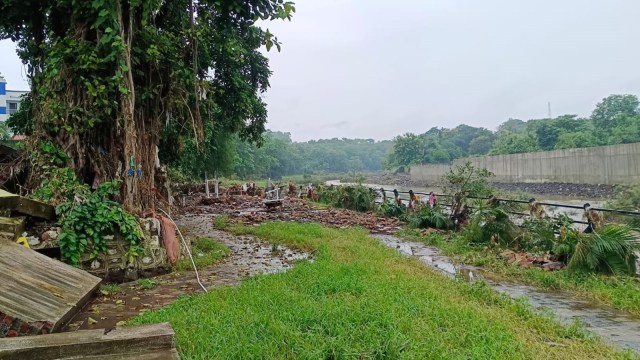Shahapur flooding: Residents blame officials’ mismanagement of Bharangi-Bhatsa river system, encroachments
Shahapur tehsildar has sought a report from the irrigation department on the overall encroachments on the riverfronts; residents concerned over the magnitude of the latest floods that left at least 150 tourists and hundreds of villagers stranded, apart from property loss.
 Destruction of the red flood line of the river (Express Photo)
Destruction of the red flood line of the river (Express Photo)Shahapur in Maharashtra’s Thane district is reeling under the threat of floods, largely attributed to human interventions and administrative mismanagement of the Bharangi-Bhatsa river system.
The residents, though are not new to the floods, are worried about the magnitude of the latest floods that left at least 150 tourists and hundreds of villagers stranded, apart from the loss of property, last week.
The Bharangi River, a tributary of the Bhatsa, originates at Mahuli Fort and flows through the Shahapur region, before it merges with the Bhatsa River in Vafe village. Bhatsa is the primary water supplier to the Shahapur and Bhiwandi regions. Encroachments on riverbanks and the construction of unauthorized structures have significantly increased flood risks.
Last week’s flash floods in Shahapur, about 70 km from Mumbai, due to heavy rain have highlighted the urgent need for effective flood management strategies.
The residents claim that the local administrative bodies have often ignored these violations, issuing permits for illegal constructions that block natural water channels. This negligence has also endangered the lives and properties of the local residents.
“The local authorities need to take immediate action to prevent further encroachments and ensure the river flows unobstructed. Timely interventions by the public and local officers can avoid such issues. The authorities have not demarcated the river boundaries which makes them treat it like a nala,” said Jyoti Gaikwad, a resident and social worker of Shahapur.
 Waste disposal in the Bharangi basin (Express Photo)
Waste disposal in the Bharangi basin (Express Photo)
The recent flash floods
On Sunday, July 7, Shahapur experienced flash floods during the midnight, significantly damaging properties and vehicles. The areas of Gujarati Baug and Chintaman Nagar were severely affected as the Bharangi River overflowed, inundating many households with up to three feet of water.
Heavy rain, which started around midnight and continued unabated until morning, resulting in flooding from 2.30 am. The sudden deluge reportedly washed away 5-6 cars and approximately 25 two-wheelers from housing societies situated along the riverbank. It is challenging to determine the extent of property loss sustained by the original inhabitants and the encroachers.
Satyadham Pawar, a resident of Shahapur, said, “The original inhabitants must get compensation from the government for their losses but not the encroachers as they are the real culprits of these floods.”
The residents also demand the government to consider deepening the Bharangi riverbed which may control the frequent flooding. “It is high time the authorities carry out the deepening of the river,” added Pawar.
Many residents voiced their frustration over the recurring issue of flooding and the lack of preventive measures by local authorities. “The issue of Bharangi flooding is not new to us, but the magnitude of this year’s floods is a matter of concern. The unchecked construction of the wall in the flow of the river is to be blamed for this worsened situation,” said Gaikwad.
“As the authorities continue to analyse the causes and impacts of these floods, we expect them to take concrete steps to address the root cause. Ensuring the preservation of natural water channels, regulating unauthorized constructions, and enhancing flood preparedness can help mitigate the impact of future floods,” Pawar further added.
Komal Thakur, tehsildar of Shahapur, said the irrigation department has been asked to submit a report on the overall encroachments on the riverfronts after his team conducted an inspection of the area on the next day of the floods and have asked “Once we get the report, we will take measures to eliminate all the encroachments and illegal constructions,” Thakur said.
 The wall on the left, garden on the right and river flowing in the centre (Express Photo)
The wall on the left, garden on the right and river flowing in the centre (Express Photo)
The wall on the bank
The recent floods in Shahapur have been attributed to the construction of a wall by the Shahapur Nagar Parishad on one side of the Bharangi river and a recreational park on the other. This construction, approved with no objection certificate (NOC) from Prashant Dhokane, an engineer with the Bhatsa project, has been called into question by government-appointed Jalnayak, Dr. Snehal Donde, who inspected the flood-affected areas.
“The officer concerned, Prashant Dhokane, deputy engineer of the Right Bhatsa Channel Project, should not have given the NOC without proper calculations and consulting senior officials. The Nagar Parishad approached for the road proposal, and it was Dhokne’s duty to check the river’s demarcation before giving the NOC. Without demarcation, people will surely take advantage, mislabelling the river as a nala,” Donde stated.
The wall, allegedly built on the river’s blue line, obstructs its natural flow and expansion, causing severe floods during the monsoon, like the one witnessed on Sunday. Donde emphasised that every river needs a riparian zone of about 6 to 7 meters, which is not maintained at the Bharangi River. “Due to the wall, the river changed its course and hit the authorized demarcated wall on the red line causing a once in 100 years kind of situation,” Donde added.
Deputy engineer Dhokane told The Indian Express, “The NOC was granted only when the Nagar Parishad approached our department with all clearances. Without blue or red line demarcations on the river, we cannot determine whether the wall obstructs the flow of the river.”
A Nagar Parishad engineer who does not wish to be named revealed that the wall was constructed to facilitate a road along the riverbank. Tehsildar Thakur said that the wall has been constructed by the Nagar Parishad as a part of a ring road project in the area under the authority of the government.
Another identified cause of these floods is the disposal of sewage and sewage water. The lack of proper sewage management in many villages has exacerbated the flood situation. B B Jadhav, the gram sevak of Vafe village, said, “There is no proper sewage disposal arrangement in the villages here, so people tend to dump all the sewage, both solid and liquid, in the river, not only resulting in flood-like conditions but also making the water unfit for drinking purposes.”
The government is building more and more dams to ensure the water security of the villages in Maharashtra, but there are no arrangements for the disposal of sewage water. “The increase in water supply results in the increase in sewage water. Though we have enough dams to cater to our water needs, we do not have resources to treat the wastewater which is eventually let into the rivers,” said Donde.
Demands for Restoration of RRZ
As riverfronts in Shahapur and neighbouring areas experienced flash floods, environmentalists blamed the Maharashtra government’s 2015 decision to scrap the River Regulatory Zone (RRZ). The RRZ restricted any development within a two-kilometre radius of rivers, which environmentalists claim facilitated unchecked industrial growth.
“The RRZ is important to have floodplains restored to allow rivers elbow room to flow during sudden downpours, mitigating flood situations,” said NatConnect director B N Kumar, emphasizing the need for restoring the RRZ to prevent such disasters. Environmentalists have been demanding the restoration of the RRZ, hoping that the Shahapur floods serve as a wake-up call for the government to act.












